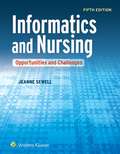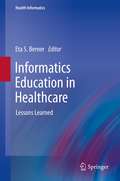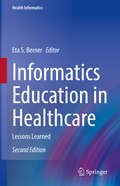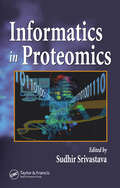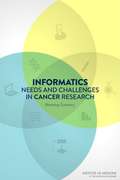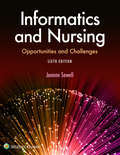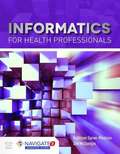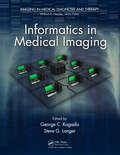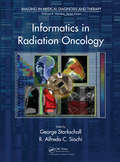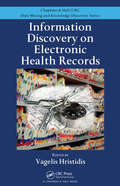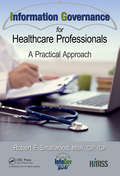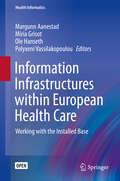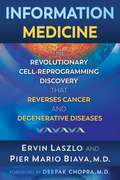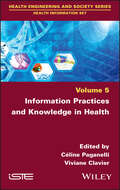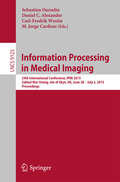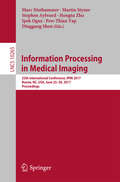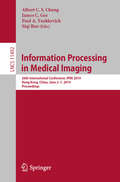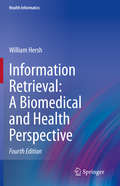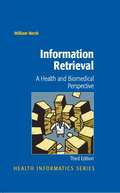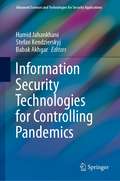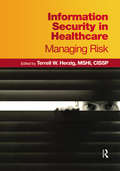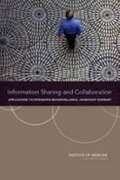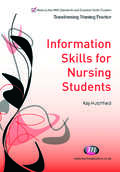- Table View
- List View
Informatics And Nursing: Opportunities And Challenges
by Jeanne SewellInformatics and Nursing: Opportunities and Challenges is a comprehensive informatics text focused on helping the nursing student learn the basics of informatics. The contents proceed from Unit One which covers computer basics to Unit Five which examines skills and techniques for using the end product of informatics: data. The text provides the foundational knowledge to understand technology and use informatics to discover and manipulate information and access, manage, retrieve, and present clinical data. This text was designed to capture cutting-edge advancement in nursing informatics core competencies and applications and to present the theories, tools, and skills that every nurse should know. The new edition has been updated for currency and has had chapters reorganized and consolidated to help students focus on important information.
Informatics Education in Healthcare: Lessons Learned
by Eta S. BernerWith the growth of the use of electronic medical records there has been a concomitant increase in training and education programs in informatics and health IT to prepare individuals as researchers, leaders, managers and developers of informatics tools, intervention and systems. This book will provide both theoretical and practical information for educators in a variety of these programs. We will include the "tacit knowledge" of experienced teachers, which is often not captured in traditional education textbooks. The book would be a blend of strategies, methods and suggested curriculum content. The book is designed to address issues common to all programs as well as education programs for special audiences. The chapter authors are all nationally recognized for their expertise in, and commitment to, informatics education. Although some chapters appear to be addressing specialized areas, there are general lessons to be learned even from those chapters in addition to the chapters that are specifically addressing general issues. The aims of the book are as follows: To address the lack of a broad based book in best practices for informatics education To provide a educational knowledge foundation for informatics educators at all levels To provide specific lessons learned in specialized informatics education areas.
Informatics Education in Healthcare: Lessons Learned (Health Informatics #92)
by Eta S. BernerThis heavily revised second edition defines the current state of the art for informatics education in medicine and healthcare. This field has continued to undergo considerable changes as the field of informatics continues to evolve. The book features extensively revised chapters addressing the latest developments in areas including relevant informatics concepts for those who work in health information technology and those teaching informatics courses in clinical settings, techniques for teaching informatics with limited resources, and the use of online modalities in bioinformatics research education. New topics covered include how to get appropriate accreditation for an informatics program, data science and bioinformatics education, and undergraduate health informatics education. Informatics Education in Healthcare: Lessons Learned addresses the broad range of informatics education programs and available techniques for teaching informatics. It therefore provides a valuable reference for all involved in informatics education.
Informatics In Proteomics
by Sudhir SrivastavaThe handling and analysis of data generated by proteomics investigations represent a challenge for computer scientists, biostatisticians, and biologists to develop tools for storing, retrieving, visualizing, and analyzing genomic data. Informatics in Proteomics examines the ongoing advances in the application of bioinformatics to proteomics researc
Informatics Needs and Challenges in Cancer Research
by Sharyl J. NassAs information technology becomes an integral part of health care, it is important to collect and analyze data in a way that makes the information understandable and useful. Informatics tools--which help collect, organize, and analyze data--are essential to biomedical and health research and development. The field of cancer research is facing an overwhelming deluge of data, heightening the national urgency to find solutions to support and sustain the cancer informatics ecosystem. There is a particular need to integrate research and clinical data to facilitate personalized medicine approaches to cancer prevention and treatment--for example, tailoring treatment based on an individual patient's genetic makeup as well as that of the tumor --and to allow for more rapid learning from patient experiences. To further examine informatics needs and challenges for 21st century biomedical research, the IOM's National Cancer Policy Forum held a workshop February 27-28, 2012. The workshop was designed to raise awareness of the critical and urgent importance of the challenges, gaps and opportunities in informatics; to frame the issues surrounding the development of an integrated system of cancer informatics for acceleration of research; and to discuss solutions for transformation of the cancer informatics enterprise. Informatics Needs and Challenges in Cancer Research: Workshop Summary summarizes the workshop.
Informatics and Nursing: Opportunities And Challenges (Coursepoint For Bsn Ser.)
by Jeanne SewellPublisher's Note: Products purchased from 3rd Party sellers are not guaranteed by the Publisher for quality, authenticity, or access to any online entitlements included with the product. Focusing on the information every nurse should know and capturing cutting-edge advances in a rapidly changing field, this practical text helps students build the communication and information literacy skills they need to integrate informatics into practice. This edition retains the key coverage of the previous edition, including office cloud computing software, interoperability, consumer informatics, telehealth, clinical information systems, social media use guidelines, and software and hardware developments, while offering new information and references throughout. Highlights of the 6th Edition Updated coverage Built-in learning aids Integrated QSEN scenarios Available with CoursePoint for Informatics and Nursing, 6th Edition Combining the world-class content of this text with Lippincott’s innovative learning tools in one easy-to-use digital environment, Lippincott CoursePoint transforms the teaching and learning experience, making the full spectrum of nursing education more approachable than ever for you and your students. This powerful solution is designed for the way students learn, providing didactic content in the context of real-life scenarios—at the exact moments when students are connecting theory to application. Features Create an active learning environment that engages students of various learning styles. Deliver a diverse array of content types—interactive learning modules, quizzes, and more—designed for today's interactive learners. Address core concepts while inspiring critical thinking. Reinforce understanding with instant SmartSense remediation links that connect students to the exact content they need at the precise moment they need it. Analyze results and adapt teaching methods to better meet individual students’ strengths and weaknesses. Empower students to learn at their own pace in an online environment available anytime, anywhere.
Informatics for Health Professionals (Navigate 2 Advantage Access)
by Dee McGonigle Kathleen MastrianNew edition available December 2019! Informatics for Health Professionals is an excellent resource to provide healthcare students and professionals with the foundational knowledge to integrate informatics principles into practice. <P><P>The theoretical underpinning of this text is the Foundation of Knowledge model, which explains how informatics relates to knowledge acquisition, knowledge processing, knowledge generation, knowledge dissemination, and feedback. Once readers understand informatics and the way in which it supports practice, education, administration, and research, they can apply these principles to improve patient care at all levels.
Informatics in Medical Imaging (Imaging in Medical Diagnosis and Therapy)
by Adam Zak Bill WaddellInformatics in Medical Imaging provides a comprehensive survey of the field of medical imaging informatics. In addition to radiology, it also addresses other specialties such as pathology, cardiology, dermatology, and surgery, which have adopted the use of digital images. The book discusses basic imaging informatics protocols, picture archiving and
Informatics in Radiation Oncology (Imaging in Medical Diagnosis and Therapy)
by George StarkschallReflecting the increased importance of the collaborations between radiation oncology and informatics professionals, Informatics in Radiation Oncology discusses the benefits of applying informatics principles to the processes within radiotherapy. It explores how treatment and imaging information is represented, stored, and retrieved as well as how t
Information Discovery on Electronic Health Records (Chapman & Hall/CRC Data Mining and Knowledge Discovery Series)
by Vagelis HristidisExploiting the rich information found in electronic health records (EHRs) can facilitate better medical research and improve the quality of medical practice. Until now, a trivial amount of research has been published on the challenges of leveraging this information. Addressing these challenges, Information Discovery on Electronic Health Records exp
Information Governance for Healthcare Professionals: A Practical Approach (HIMSS Book Series)
by Robert F. SmallwoodLike other critical organizational assets, information is a strategic asset that requires high level of oversight in order to be able to effectively use it for organizational decision-making, performance improvement, cost management, and risk mitigation. Adopting an information governance program shows a healthcare organization’s commitment to managing its information as a valued strategic asset. Information governance serves the dual purpose of optimizing the ability to extract clinical and business value from healthcare information while meeting compliance needs and mitigating risk. Healthcare organizations that have information governance programs will have a competitive edge over others and contributes to safety and quality of care, population health, operational efficiency and effectiveness, and cost reduction initiatives. This is a much-needed book in the healthcare market space. It will explain, in clear terms, how to develop, launch, and oversee an Information Governance program. It also provides advice and insights from leading IG, cybersecurity and information privacy professionals in healthcare.
Information Infrastructures within European Health Care
by Margunn Aanestad Miria Grisot Ole Hanseth Polyxeni VassilakopoulouThis book is open access under a CC BY-NC 2. 5 license. The book aims to be a resource for those interested in planning and implementing large-scale information infrastructures for novel electronic services in health care. The focus of this book is on the pivotal role of the installed base (i. e. the already existing elements of an infrastructure) for ensuing infrastructural development. The book presents rich empirical cases on the design, development and implementation of core infrastructural components (e-prescription and public patient-oriented web platforms) in different national settings across Europe. Therefore, this is a book in which theoretical insights and practical experiences are tightly connected. Contributions have been sourced from a network of academics that have been working on the topic for years, and who have previously collaborated and shared a common understanding of the challenges entailed in expanding information infrastructures within healthcare. The book aims to become a reference for those seeking theoretical and empirical insights for conceptualizing and steering the evolution of information infrastructures in healthcare. The two types of systems (e-prescription and public patient-oriented web platforms) have been selected because they are widespread across Europe, because they invite comparisons, and because they are exemplary of two different types of aims. E-prescription initiatives are usually seen as opportunities to improve healthcare delivery by systematic and not dramatic change. Public patient-oriented web platforms are seen as opportunities to pursue wider and more radical innovation. This book targets researchers, practitioners and students who would benefit from a book providing a comprehensive view to contemporary approaches for the design and deployment of large-scale, inter-organizational systems within healthcare. This book is open access under a CC BY 4. 0 license.
Information Medicine: The Revolutionary Cell-Reprogramming Discovery that Reverses Cancer and Degenerative Diseases
by Ervin Laszlo Pier Mario BiavaA look at the future of medicine based on cutting-edge stem cell research • Shares Dr. Biava’s groundbreaking research on stem cell differentiation stage factors (SCDSFs) as a cellular “reprogramming” treatment for cancer and other degenerative diseases • Explains how SCDSFs restore communication between cells and the epigenetic code, the information that programs the normal function and growth of every living cell • Explores how the universe operates like a cosmic information-network and how this new scientific worldview will shape the future of healing and medicine The universe is not a mechanical system of matter--it operates like a cosmic network that runs on and is connected by information. Information “in-forms” and underlies all of the physical world, including the human body. In this book, Pier Mario Biava, M.D., and Ervin Laszlo, Ph.D., show how this “information” worldview can be applied to healing and medicine and, specifically, how it underlies a revolutionary new approach to cancer and disease treatment, one that works directly with the epigenetic code--the information that programs the function and growth of every living cell. The authors explain how tumor growth and cellular dysfunction are manifestations of disconnections in the information network of an organism. Unveiling Dr. Biava’s groundbreaking research on stem cell differentiation stage factors (SCDSFs), they explain how SCDSFs work directly as epigenetic regulators to reconnect aberrant cells to the body’s information network and reset them to their original function--in the case of cancer cells transforming them from malignant to benign, from dysfunction back to normalcy and health. Dr. Biava’s research on SCDSFs--derived from Zebrafish embryos, which have a very high percentage of proteins identical with those of human beings--has shown good success in reprogramming and inhibiting cancer cells in clinical trials with patients with advanced liver cancer, as well as success in in vitro studies with 7 different human tumor lines. SCDSFs have also shown promise in the treatment of chronic diseases such as psoriasis and neurodegenerative diseases. This research will also allow the development of new treatments for Alzheimer’s, Parkinson’s, and multiple sclerosis. Unveiling the holistic future of medicine, the authors show how we will no longer need to approach the treatment of cancer and other degenerative diseases as a “fight,” but as a restoration of our cells’ original programming. With the advent of Information Medicine, we now have the power to program ourselves to heal.
Information Practices and Knowledge in Health
by Viviane Clavier Céline PaganelliIn the field of health, information practices and the organization of knowledge constitute a major challenge today. The practices of the medical profession, or of patients, are evolving under the influence of digital technology. At the same time, the way in which medical knowledge is organized, represented and mediated is also evolving.Information Practices and Knowledge in Health addresses the different aspects of the field of specialized medical and health information; it focuses on the informational practices of professionals in the sector, of patients and, more broadly, of citizens with regards to their health. This book also considers the systems that are used for organizing knowledge in this field.
Information Privacy in the Evolving Healthcare Environment (HIMSS Book Series)
by Linda KoontzAdvances in health information technology (health IT) have the potential to improve the quality of healthcare, to increase the availability of health information for treatment, and to implement safeguards that cannot be applied easily or cost-effectively to paper-based health records. However, the digitization of health information is also raising new privacy risks and concerns. Sensitive health information in digital form is more easily aggregated, used, and shared. In addition, the rising cost of healthcare and the search for efficiency may create incentives to use the information in new ways. Research has consistently shown that while the public sees the potential value of health information exchange and technological advancements, it remains gravely concerned about the privacy of their sensitive health information. As a result, it is becoming increasingly clear that ensuring public trust will be critical to the successful implementation of nationwide health information exchange. The purpose of this second edition is two-fold: 1) to educate readers about privacy concepts and 2) highlight key privacy issues facing the nation and the healthcare community as it moves towards electronic health records and health information exchange. The first three chapters are descriptive in nature, defining privacy and distinguishing it from security, defining the complex legal landscape for health information privacy, and setting the stage for the following chapters by describing the current landscape of the evolving healthcare environment. The following chapters discuss specific privacy issues and challenges in detail. The book concludes with a chapter providing a view to the future of healthcare and the association privacy implications. This is an updated version of one of HIMSS’ best-selling books on information privacy.
Information Processing in Medical Imaging
by Daniel C. Alexander Carl-Fredrik Westin Sebastien Ourselin M. Jorge CardosoThis book constitutes the proceedings of the 24th International Conference on Information Processing in Medical Imaging, IPMI 2015, held at the Sabhal Mor Ostaig College on the Isle of Skye, Scotland, UK, in June/July 2015. The 22 full papers and 41 poster papers presented in this volume were carefully reviewed and selected from 195 submissions. They were organized in topical sections named: probabilistic graphical models; MRI reconstruction; clustering; statistical methods; longitudinal analysis; microstructure imaging; shape analysis; multi-atlas fusion; fast image registration; deformation models; and the poster session.
Information Processing in Medical Imaging: 25th International Conference, IPMI 2017, Boone, NC, USA, June 25-30, 2017, Proceedings (Lecture Notes in Computer Science #10265)
by Marc Niethammer, Martin Styner, Stephen Aylward, Hongtu Zhu, Ipek Oguz, Pew-Thian Yap and Dinggang ShenThis book constitutes the proceedings of the 25th International Conference on Information Processing in Medical Imaging, IPMI 2017, held at the Appalachian State University, Boon, NC, USA, in June 2017. The 53 full papers presented in this volume were carefully reviewed and selected from 147 submissions. They were organized in topical sections named: analysis on manifolds; shape analysis; disease diagnosis/progression; brain networks an connectivity; diffusion imaging; quantitative imaging; imaging genomics; image registration; segmentation; general image analysis.
Information Processing in Medical Imaging: 26th International Conference, IPMI 2019, Hong Kong, China, June 2–7, 2019, Proceedings (Lecture Notes in Computer Science #11492)
by James C. Gee Paul A. Yushkevich Siqi Bao Albert C. ChungThis book constitutes the proceedings of the 26th International Conference on Information Processing in Medical Imaging, IPMI 2019, held at the Hong Kong University of Science and Technology, Hong Kong, China, in June 2019. The 69 full papers presented in this volume were carefully reviewed and selected from 229 submissions. They were organized in topical sections on deep learning and segmentation; classification and inference; reconstruction; disease modeling; shape, registration; learning motion; functional imaging; and white matter imaging. The book also includes a number of post papers.
Information Retrieval: A Health And Biomedical Perspective (Health Informatics)
by William HershThis extensively revised 4th edition comprehensively covers information retrieval from a biomedical and health perspective, providing an understanding of the theory, implementation, and evaluation of information retrieval systems in the biomedical and health domain. It features revised chapters covering the theory, practical applications, evaluation and research directions of biomedical and health information retrieval systems. Emphasis is placed on defining where current applications and research systems are heading in a range of areas, including their use by clinicians, consumers, researchers, and others. Information Retrieval: A Biomedical and Health Perspective provides a practically applicable guide to range of techniques for information retrieval and is ideal for use by both the trainee and experienced biomedical informatician seeking an up-to-date resource on the topic.
Information Retrieval: A Health and Biomedical Perspective
by William HershThe third edition of this book will reach across disciplines and address the needs of not only those who study, evaluate, and purchase health information, but also computer and library/information scientists, information technology developers building databases, search engines, Web sites, and other systems for universities and hospitals who enthusiastically read the first two editions. The book is divided into three sections: Basic Concepts, State of the Art and Research Directories. Major changes to the this edition will include a new chapter in the State of the Art section on Digital Libraries and a new focus on areas related to information retrieval systems covering such topics as electronic publishing of journals and other scientific materials, emerging standards, open access publishing issues, digital preservation, that summarize and categorize documents to handle the vast amount of information that is now available. Web updates, which include keeping track of new systems, technologies, studies, are folded into the third edition to show the advancement from 1996 to present time.
Information Security Technologies for Controlling Pandemics (Advanced Sciences and Technologies for Security Applications)
by Babak Akhgar Hamid Jahankhani Stefan KendzierskyjThe year 2020 and the COVID-19 pandemic marked a huge change globally, both in working and home environments. They posed major challenges for organisations around the world, which were forced to use technological tools to help employees work remotely, while in self-isolation and/or total lockdown. Though the positive outcomes of using these technologies are clear, doing so also comes with its fair share of potential issues, including risks regarding data and its use, such as privacy, transparency, exploitation and ownership. COVID-19 also led to a certain amount of paranoia, and the widespread uncertainty and fear of change represented a golden opportunity for threat actors. This book discusses and explains innovative technologies such as blockchain and methods to defend from Advanced Persistent Threats (APTs), some of the key legal and ethical data challenges to data privacy and security presented by the COVID-19 pandemic, and their potential consequences. It then turns to improved decision making in cyber security, also known as cyber situational awareness, by analysing security events and comparing data mining techniques, specifically classification techniques, when applied to cyber security data. In addition, the book illustrates the importance of cyber security, particularly information integrity and surveillance, in dealing with an on-going, infectious crisis. Aspects addressed range from the spread of misinformation, which can lead people to actively work against measures designed to ensure public safety and minimise the spread of the virus, to concerns over the approaches taken to monitor, track, trace and isolate infectious cases through the use of technology. In closing, the book considers the legal, social and ethical cyber and information security implications of the pandemic and responses to it from the perspectives of confidentiality, integrity and availability.
Information Security in Healthcare: Managing Risk (HIMSS Book Series)
by Terrell W. HerzigInformation Security in Healthcare is an essential guide for implementing a comprehensive information security management program in the modern healthcare environment. Combining the experience and insights of top healthcare IT managers and information security professionals, this book offers detailed coverage of myriad
Information Sharing and Collaboration: Workshop Summary
by Deepali M. PatelAfter the September 11, 2001, terrorist attacks and subsequent anthrax mailings, the U. S. government prioritized a biosurveillance strategy aimed at detecting, monitoring, and characterizing national security health threats in human and animal populations, food, water, agriculture, and the environment. However, gaps and challenges in biosurveillance efforts and integration of biosurveillance activities remain. September 8-9, 2011, the IOM held a workshop to explore the information-sharing and collaboration processes needed for the nation's integrated biosurveillance strategy.
Information Skills for Nursing Students (Transforming Nursing Practice Series)
by Kay HutchfieldIt is essential for nursing students to access current and reliable information to succeed in academic assignments and nursing practice, yet there are increasingly diverse information sources available, which can raise questions about the authenticity and reliability of information provided. This book presents a practical and clear guide to mastering information skills. It shows the reader how to effectively plan and implement a search for information and make judgements on the quality of the sources found. It also gives strategies for storage and retrieval of information, helping nurses to maximise the time they have available for keeping up to date.
Information Systems and Neuroscience: Gmunden Retreat On Neurois 2016 (Lecture Notes in Information Systems and Organisation #16)
by Jan Vom Brocke René Riedl Pierre-Majorique Léger Fred D. Davis Adriane B. RandolphThis book presents the proceedings of the NeuroIS Retreat 2018, June 19-21, Vienna, Austria, reporting on topics at the intersection of Information Systems (IS) research, neurophysiology and the brain sciences. Readers will discover the latest findings from top scholars in the field of NeuroIS, which offer detailed insights on the neurobiology underlying IS behavior, essential methods and tools and their applications for IS, as well as the application of neuroscience and neurophysiological theories to advance IS theory.
